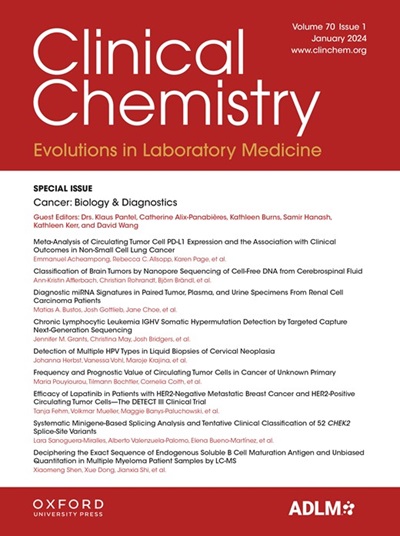A-356 用于从鼻拭子样本中快速灵敏识别呼吸道病毒的手持式微流控平台
IF 6.3
2区 医学
Q1 MEDICAL LABORATORY TECHNOLOGY
引用次数: 0
摘要
背景用快速准确的检测方法确定受感染的个体,对于遏制病毒传播和提供适当的治疗至关重要。抗原快速检测(ART)为患者提供了快速的感染筛查,但由于其灵敏度低于核酸检测方法,因此在检测早期感染和专利的完全恢复方面表现不佳。另一方面,传统的核酸检测方法仪器笨重、成本高昂、过程繁琐且耗时长,也不利于筛查。德尔塔公司正在开发一种采用分子技术的全自动手持式 POC,可在 20 分钟内同时检测 4 个目标。该 POC 既可独立使用,也可与手机或 PC 应用程序连接,用于不同的应用场景。专有配方的裂解缓冲液可在几秒钟内中和样品中的抑制因子,有效裂解病原体。含有冻干试剂的微流控芯片可在室温下保存。扩增信号通过比色 LAMP 的光学系统进行检测。本研究旨在评估 POC 系统检测鼻拭子中 SARS-CoV2 (SC2)、FluA 和 B 病毒的性能。此外,还将该检测方法的性能与现有的其他商业产品作了进一步比较。方法 将减毒的 SC2 病毒、FluA 病毒和 B 病毒用 1xTE 稀释成不同浓度。稀释后的病毒按 5%的 v/v 比例添加到裂解缓冲液中。根据制造商的说明,将从捐献者处采集的鼻腔样本浸泡并在含有裂解缓冲液的滤芯中旋转。对于不含裂解缓冲液的商业产品,则直接使用拭子。然后将试剂盒放入相应的设备中进行进一步检测。结果 在有 Delta 溶菌缓冲液(含冻干中和剂)的情况下,冻干 SC2 检测试剂盒能在真实鼻腔样本中检测到 1000 拷贝/毫升的病毒(20 例中有 20 例)。但是,如果不使用裂解缓冲液,即使存在 240 倍 LoD 病毒,也检测不到任何信号。整个工作流程的灵敏度在 Delta 手持式系统上用 1x、4x、10x LoD 的 SC2 阳性样本和鼻腔样本基质中的阴性样本进行了测试。结果通过嵌入式算法进行处理,并分别显示在设备、电脑和移动应用程序上。在检测的 79 份阳性样本中,检出率为 100%。在检测的 31 个阴性样本中,没有出现假阳性检测。阳性内部对照表明运行有效。成功检测出 5 种主要的 SC2 亚型(对 366 707 株菌株进行了 99.8% 的硅学分析)、10 种 FluA 和 9 种 FluB 亚型。此外,与基准商业平台≥50,000 个拷贝/盒的 SC2 LoD 相比,Delta 手持式平台的 LoD 为 500 个拷贝/盒。结论 我们开发的手持式分子检测系统在呼吸系统小组检测中表现出了快速、灵敏和有竞争力的分析性能。该系统可将设备连接到应用程序和云端进行数据管理,其可扩展的对接系统可让多台设备同时独立运行样本,这使其既适用于临床环境,也适用于家庭使用的传染病筛查。本文章由计算机程序翻译,如有差异,请以英文原文为准。
A-356 A hand-held microfluidic platform for rapid and sensitive identification of respiratory viruses from nasal swab samples
Background Identifying the infected individual with a fast and accurate test is essential to constrain the spread of viruses and provide the proper treatment. Antigen rapid test (ART) provides quick screening of infection for patients; however, it shows less promising in the detection of early infection and patent’s full recovery as its inferior sensitivity to the nucleic acid detection method. On the other hand, bulky and costly instrument, tedious and prolonged procedures in traditional nucleic acid testing is also unfavorable for the screening. Delta is developing a fully automated hand-held POC using molecular technology to simultaneously detect 4 targets in 20 mins. The POC can be stand-alone or linked to mobile or PC app for different application scenarios. The proprietary recipe of the lysis buffer could neutralize the inhibition in the sample with effective pathogen lysis in seconds. The microfluidic cartridge containing lyophilized reagent can be stored at room temperature. The amplification signal is detected via the optical system from the colorimetric LAMP. This study is to evaluate the performance of the POC system in detecting SARS-CoV2 (SC2), FluA and B viruses in nasal swab. In addition, the assay performance was further compared with other commercial products available. Methods The attenuated SC2 virus, FluA and B viruses were diluted with 1xTE into different concentrations. The diluted viruses were spiked into the lysis buffer in 5% v/v ratio. Nasal samples collected from donors were soaked and swirled inside the cartridges containing lysis buffer according to the manufacturers’ instructions. For commercial products without lysis buffer, direct swabs were used. The cartridges were then put into the respective devices for further testing. Results The lyophilized SC2 assay consistently detected the viruses at 1000 copies/ml (20 out of 20) in real nasal samples in the presence of Delta Lysis Buffer (containing lyophilized neutralizer). However, without Lysis buffer, there was no signal detected even in the presence of 240x LoD viruses. The whole workflow sensitivity was tested with SC2 positive samples at 1x, 4x, 10x LoD and negative samples in the nasal sample matrix on Delta hand-held system. The results were processed via embedded algorithm and displayed on device as well as on PC and mobile app respectively. Out of 79 positive samples tested, the detection rate was 100%. There was no false positive detection for 31 negative samples tested. Positive internal control indicated the valid runs. 5 major SC2 subtypes (99.8% in silico analysis of 366,707 strains), 10 FluA and 9 FluB subtypes were successfully detected. Further, Delta hand-held platform outperformed in the LoD of SC2 with 500 copies/swab comparing to the ≥50,000 copies/swab of the benchmarked commercial platforms. Conclusions The performance of the hand-held molecular detection system we developed demonstrated a rapid, sensitive, and competitive analytical performance in the respiratory panel detection. The capability of device linking to apps and clouds for data management and the extendable docking system for multiple devices to run samples simultaneously and independently, make it applicable for the infectious diseases screening in both clinical settings and for home-use.
求助全文
通过发布文献求助,成功后即可免费获取论文全文。
去求助
来源期刊

Clinical chemistry
医学-医学实验技术
CiteScore
11.30
自引率
4.30%
发文量
212
审稿时长
1.7 months
期刊介绍:
Clinical Chemistry is a peer-reviewed scientific journal that is the premier publication for the science and practice of clinical laboratory medicine. It was established in 1955 and is associated with the Association for Diagnostics & Laboratory Medicine (ADLM).
The journal focuses on laboratory diagnosis and management of patients, and has expanded to include other clinical laboratory disciplines such as genomics, hematology, microbiology, and toxicology. It also publishes articles relevant to clinical specialties including cardiology, endocrinology, gastroenterology, genetics, immunology, infectious diseases, maternal-fetal medicine, neurology, nutrition, oncology, and pediatrics.
In addition to original research, editorials, and reviews, Clinical Chemistry features recurring sections such as clinical case studies, perspectives, podcasts, and Q&A articles. It has the highest impact factor among journals of clinical chemistry, laboratory medicine, pathology, analytical chemistry, transfusion medicine, and clinical microbiology.
The journal is indexed in databases such as MEDLINE and Web of Science.
 求助内容:
求助内容: 应助结果提醒方式:
应助结果提醒方式:


